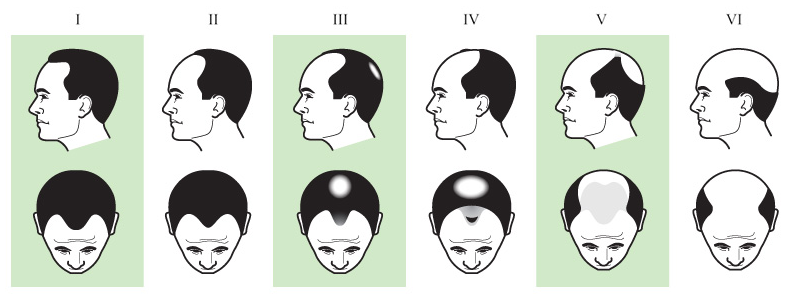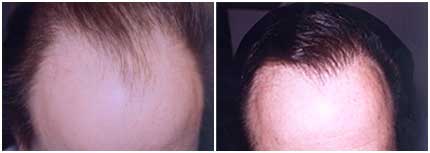Hair Loss Evaluation
Written by Dr. Griffin
Advanced Techniques to Recognize the Signs of Thinning Hair and Balding in Philadelphia
It’s normal to lose some hair as time goes on, but men and women alike may be alarmed if their hair loss occurs suddenly, for no apparent reason, or they are experiencing excessive hair shedding. Using a hair loss evaluation at the Philadelphia-based Griffin Hair Restoration Center, Dr. Thomas Griffin and his team make it their goal to get to the root of the problem—no pun intended—so that they can advise you on the most suitable treatment to restore a fuller head of hair.
In most cultures around the world, hair is thought to symbolize health, strength, and attractiveness. Research has shown that hair loss can be psychologically damaging and difficult for many people to cope with. Since hair has an impact on the way we look, and thinning or balding areas may contribute to a more aged appearance, hair loss can trigger a loss of confidence and have a negative impact on self-esteem. Once the cause is identified with a hair loss evaluation, there are several surgical and non-surgical options for those who want to address thinning hair.
Ready to schedule a hair loss evaluation from the Philadelphia-based team at The Griffin Hair Restoration Center? Call (215) 561-9100 or submit a contact form if you would like to request a consultation.
Real Patient Before & After Photos
What Is Hair Loss?
It’s perfectly normal and healthy to shed between 50 to 100 hairs per day. This light shedding usually isn’t anything you need to worry about, since it’s part of the hair loss cycle—but if you are losing significantly more hair than that, the loss can be considered excessive hair shedding. When this happens, there can be an underlying condition that is causing the hair to fall out, as well as possibly feel thin or excessively fine.
If you find yourself asking “Why am I suddenly losing so much hair?” know that the first step is a hair loss evaluation. There are a variety of elements that may contribute to hair loss, including hereditary factors, hormonal changes, medical conditions, and normal aging.
What Role Do Genetics Play in Hair Loss Evaluation?
Our genes play an important part in many of our physical traits, including everything from eye and hair color to our ability to maintain a thick head of hair as we age. Patients who are having a hair loss evaluation are often curious about how genetics affect hair shedding.
Despite being thought of as an issue that affects men, genetics have a major impact on hair loss for both men and women. The genetic aspect of hair loss is still being researched, but it is believed that many different genes can contribute to the problem.
Hair loss that is caused by genetics occurs gradually in a typically predictable pattern. This is what is called male pattern baldness (MPB) or female pattern baldness (FPB). The genes for this condition are inherited from both sides of the family.
Patients who have MPB usually have male family members with similar patterns of hair shedding. This is because high levels of male hormones called androgens not only cause the hairs to become thinner and shorter, but they also reduce hair growth overall. Genetics affect the way hair follicles respond to androgens.
Hair loss evaluation patients will often ask, “Is it possible to stop hair loss if it’s genetic?” Unfortunately, the genetic factors that cause balding can’t be touched. However, patients can take steps to reduce their hair shedding and promote new hair growth. If you are noticing early signs of balding, it is best to have a hair loss evaluation as early as possible in order to start a treatment sooner as opposed to later. That is the ideal way to maximize preservation of the remaining hair.
Medical History for Hair Loss Evaluation
Dr. Thomas Griffin will need to gather information from a patient in order to begin the hair loss evaluation. Each patient will be asked a variety of questions during the hair loss evaluation, including when the hair loss started, the patterns of hair loss that are occurring, the hairstyles they wear most often, whether other members of their family have experienced hair loss, any other symptoms they are having, and other medical conditions they may have. Dr. Griffin may also ask about diet and hair care routines during the hair loss evaluation.
What Does a Physical Examination During a Hair Loss Evaluation Involve?
“How do you diagnose hair loss?” “What tests should be done for hair loss?” Many patients have questions about what to expect from their hair loss evaluation. Here’s what patients searching for cures for hair thinning and balding in 2022 and 2023 should know.
During a hair loss evaluation, it is often possible for Dr. Griffin to determine what is causing the loss simply by looking at your hair. He can visually assess the pattern of the hair loss to determine what is causing any thinning by examining the scalp and determining the pattern and degree of loss.
Interested in having a hair loss evaluation by the Philadelphia-based team at Griffin Hair Restoration Center? Call (215) 561-9100 or submit a contact form for more information.
Which Tests Are Used for Hair Loss Evaluation?
There are a few physical examinations and simple tests used in hair loss evaluation in order to help with the diagnosis. These hair loss evaluation tests help Dr. Griffin to find out more about the health of your hair. Such tests include:
Scalp and Hair Shaft Exam
The scalp provides important clues for a hair loss evaluation. It is important to assess the health of the scalp, since scarring, redness, and scaling are signs of particular hair thinning disorders. Any unusual signs or an otherwise unhealthy scalp can help point Dr. Griffin to the cause of balding or thinning. The appearance of the hair shaft can also point to possible hair breakage conditions.
Tug Test/Pull Test
In this test, a section of hair is gently “pulled,” and the amount of hair that subsequently comes out as a result is evaluated. If hairs come out easily, the presence of a hair thinning disease is typically validated. The hair that comes out due to this hair loss evaluation test can be further analyzed more directly under a microscope.
Thyroid Assessment
Thyroid disease is a medical condition that may be associated with alopecia. Low thyroid (hypothyroidism) can cause thinning on the scalp, as well as a loss of eyebrows. Hyperthyroidism caused by various diseases may be associated with alopecia areata. This may require more testing after the initial hair loss evaluation.
What Is the Hair Loss Evaluation Grading Scale?
There are several different types of classifications scales used to diagnose the extent of a person’s baldness for a hair loss evaluation. The two most referenced grading scales used in hair loss evaluation are the “Norwood” scale for men and the “Ludwig” scale for women. These scales allow Dr. Griffin to determine the severity of the thinning and find the best possible treatment. The Ludwig Scale for identifying female pattern baldness consists of three stages, with Type 1 showing the earliest signs of balding and Type 3 being the most severe.
 Fig 1. As seen in this image, the Norwood grading scale for men ranges from 1, which shows no sign of balding, to 7, which is the most severe form of balding. In the most dramatic form of pattern baldness, the scalp is nearly completely bald and is lined by hair on the sides and back of the scalp.
Fig 1. As seen in this image, the Norwood grading scale for men ranges from 1, which shows no sign of balding, to 7, which is the most severe form of balding. In the most dramatic form of pattern baldness, the scalp is nearly completely bald and is lined by hair on the sides and back of the scalp.
Real Patient Before & After Photos
Which Diagnostic Procedures Are Used for Hair Loss Evaluation?
Sometimes more information will be needed for a hair loss evaluation. If Dr. Griffin believes that there may be an underlying medical condition such as a disease, vitamin deficiency, hormone imbalance, or infection that is causing the hair to shed excessively, he may recommend that the patient have a blood test or scalp biopsy for hair loss evaluation. Lab tests may be helpful in a hair loss evaluation when it comes to understanding the cause of a patient’s baldness.
Moreover, Dr. Griffin may advise a scalp biopsy as part of a hair loss evaluation to assess the pathology of a scalp disease in question. The biopsy involves taking a small sample of tissue—roughly 4 mm, about the size of a pencil eraser—and is performed in the office with local anesthesia.
What Solutions Are Available for Hair Loss?
Treatments for hair loss will typically include surgery or medications. Our Griffin Hair Restoration Center of Philadelphia team offers several surgical and non-surgical solutions to consider if you have had a hair loss evaluation and determine the cause of the condition. Some of the surgical solutions available for patients include a male hair transplant, female hair transplant, ethnic hair transplant, and corrective hair transplant. Platelet-rich plasma (PRP) is a non-surgical technique for stimulating hair growth by improving the blood supply to hair follicles and increasing the thickness of hair shafts.
Discover more about the benefits of a hair loss evaluation from the Philadelphia-based team at The Griffin Hair Restoration Center. Call (215) 561-9100 or submit a contact form to request a consultation.



